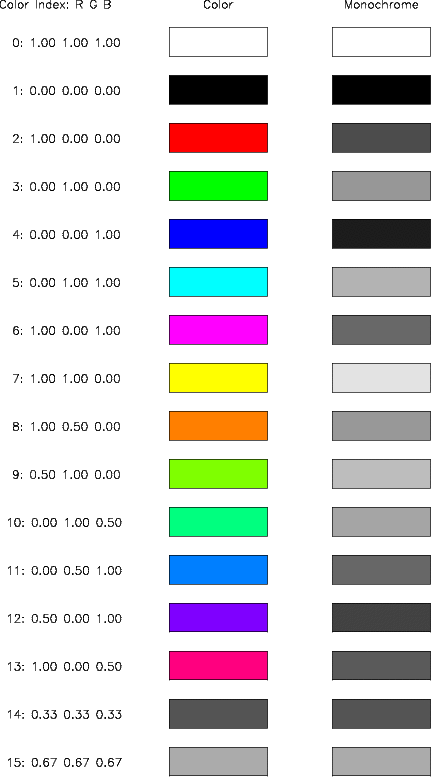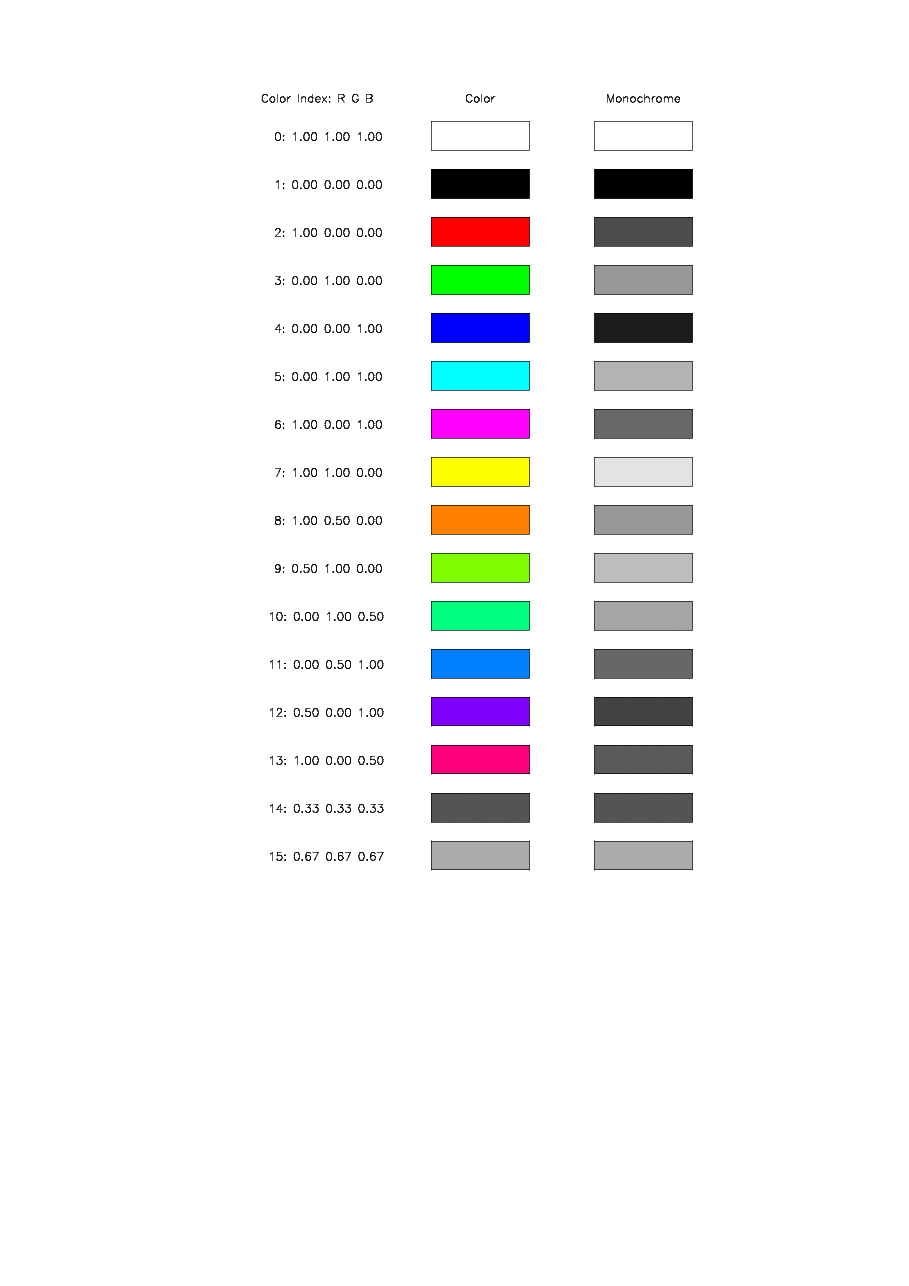A Formula Collection
In this formula collection, those formulae are summarized which are used in the programs of the
Tübingen NLTE Model-Atmosphere Package (TMAP). The abbreviations for the different
transitions (CBF- ...) refer to those of Sect. 1. The last numbers of the section titles are
the formula numbers which have to be inserted in the atomic data file (ATOMS, Sect. 2,
2.2).
A.1 CBB Transitions
A.1.1 van-Regemorter Formula (Allowed Dipole Transitions)

![u0 = hnij/kT , E0 = hnij, Γ (u0 ) = max [¯g, 0.276eu0E1 (u0 )]](UserGuide54x.gif)
 = 0.2 for n’
= 0.2 for n’ n else = 0.7. EH is the ionization energy of the hydrogen ground state.
n else = 0.7. EH is the ionization energy of the hydrogen ground state.
 2
input parameters: fij,
2
input parameters: fij, 
A.1.2 Forbidden Transitions

 NFIT+1 input parameters: NFIT, a1, ... , aNFIT
NFIT+1 input parameters: NFIT, a1, ... , aNFIT
for the effective collision strength. Is only one parameter supplied (explicitly: 1), then Ω = 1 is
set.
A.1.3 Hydrogen
following Mihalas

 no
input parameter
no
input parameter
A.1.4 He II
following Mihalas & Stone

![[ ]
n----1-
g = min [ni, 1.1] .min Δni, ni - Δn](UserGuide64x.gif) no
input parameter
no
input parameter
A.1.5 He I: Allowed Transitions from its Ground State
following Mihalas & Stone
 1
input parameter: f1j
1
input parameter: f1j
A.1.6 He I: Allowed Transitions but not from its Ground State
following Mihalas &
Stone

 1
input parameter: fij
1
input parameter: fij
A.1.7 He I: Forbidden Transitions from its Ground State
following Mihalas & Stone
![------ -- [ ]
C = pa 2 V~ -8k--n V~ T--a---u --1--- a E (u ) + a u e-b1u0x + a u e- b2u0x
ij 0 pme e neff 3 0pa02 0 1 0 1 0 1 2 0 2](UserGuide68x.gif)

 8
input parameters: a, ai, bi, ci (found in tabular form in M&S; Attention: their equation A16 is
wrong!)
8
input parameters: a, ai, bi, ci (found in tabular form in M&S; Attention: their equation A16 is
wrong!)
A.1.8 He I: Forbidden Transitions between its n = 2 Sublevels
following Mihalas &
Stone


 3
input parameters: c0, c1, c-2 (in tabular form by M&S)
3
input parameters: c0, c1, c-2 (in tabular form by M&S)
A.1.9 Unknown Collisional Cross-Sections
 no
input parameter
no
input parameter
A.1.10 Ω-Fit of 3rd Degree
like A.1.2, but:
 4
input parameters: a1, a2, a3, a4
4
input parameters: a1, a2, a3, a4
A.1.11 Mg II: Allowed Transitions from its Ground State
following Mihalas (1972)
 2
input parameters: a, b
2
input parameters: a, b
A.1.12 van-Regemorter: Combined Levels of Complex Ions

![log Γ (T ) = a + a x + a x2 + a x3, x = log kT [in eV ]
ij 0 1 2 3](UserGuide78x.gif) 4
input parameters: a0, a1, a2, a3
4
input parameters: a0, a1, a2, a3
A.1.21 He I: Transition between its Levels with s < 4
D. Hummer, priv. comm.
no input parameter
A.1.25 Ω-Fit in Temperature, General Case
equal to DETAIL Formula No. 25,
8 input parameters
A.1.26 Ω-Fit in log T, General Case
equal to DETAIL Formula No. 26,
 NFIT+2 input parameters: T1, NFIT, a1, ..., aNFIT
NFIT+2 input parameters: T1, NFIT, a1, ..., aNFIT
A.2 CBF Transitions
A.2.1 Hydrogen, n = 1,..., 10
following Mihalas
 own
fit formulae for Γ, because Mihalas is restricted in temperature,
own
fit formulae for Γ, because Mihalas is restricted in temperature,
no input parameter
A.2.2 He II, n = 1,..., 10
following Mihalas, like CBF1, own fit formulae for Γ, because Mihalas is
restricted in temperature,
no input parameter
A.2.3 He I, n < 15

 1
input parameter:
1
input parameter:  0 (in tabular form by Mihalas & Stone)
0 (in tabular form by Mihalas & Stone)
A.2.4 Seaton Formula
![13 -1---- u0 - 1
Cik = 1.55 .10 ¯gs0ne V~ --e u0 ¯g = [0.1,0.2, 0.3] for Z = [1,2, > 3]
T](UserGuide83x.gif) Z =
charge of the ion
Z =
charge of the ion  0 = threshold photoionization cross-section
0 = threshold photoionization cross-section
2 input parameters:  0,
0, 
In case that formula 4 is requested and a cross-section of 0.0 inserted, a mean cross-section (at the
threshold energy) of the Opacity Project data is calculated and used as threshold cross-section
(Sect. A.4).
A.2.5 Lotz Formula
 3
input parameters: P,
3
input parameters: P,  , c
, c
u1 = u0 + c
A.2.6 Mg II 3s  Mg III 2p6 +
Mg III 2p6 + 
following Mihalas (1972)
![------ ( )2
C = pa 2 V~ -8k--n V~ T- EH-- {au E (u ) + b (u /u )2[E (u ) + e-u1]}
ik 0 pme e E0 0 1 0 0 1 1 1](UserGuide86x.gif)
 3
input parameters: a, b, c
3
input parameters: a, b, c
A.3 RBB Transitions
A.3.1 Doppler Profiles

 1
input parameter: fij
1
input parameter: fij
A.3.2 Voigt Profiles, only Radiative Damping

 2
input parameters: fij, Γ
2
input parameters: fij, Γ
A.3.3 Voigt Profiles, Radiative and Collisional Damping (Electrons)
 ij like in A.3.2, but:
ij like in A.3.2, but:

 (Cowley 1970, 1971) 3 input parameters: fij, Γrad,
(Cowley 1970, 1971) 3 input parameters: fij, Γrad,  2
2
A.3.4 Voigt Profiles and “Stark Wings” (Linear Stark Effect)
![[ Formel 3 St]
sij = max sij ,sij](UserGuide95x.gif)


![[NION ]23
sum 32
zMikro = Zi .ni
i=1](UserGuide98x.gif) 6
input parameters: fij, Γrad,
6
input parameters: fij, Γrad,  2, Z, n
low, nup
2, Z, n
low, nup
A.3.5 Stark Line Broadening following Dimitrijévic
like formula 3
A.4 RBF Transitions
A.4.1 Seaton Formula
![( )s [ ]
s = s nth- a + (1 - a )nth-
n 0 n n](UserGuide100x.gif)

with the effective principal quantum number

gII is the bound-free gaunt factor
z core charge of the ion
3 input parameters:  0,
0, ,s
,s
A.4.2 Seaton Formula with Gaunt Factor
![( ) [ ]
nth- s nth-
sn = s0 n a + (1 - a ) n gII (x, y,z )](UserGuide103x.gif) 6
input parameters:
6
input parameters:  0,
0, ,s,x,y,z
,s,x,y,z
A.4.3 Koester Formula for He I
A&A,
![ln (gsn ) = a0 + a1 ln c + a2 ln2 c, c[˚A ]](UserGuide104x.gif) 3
input parameters: a0,a1,a2
3
input parameters: a0,a1,a2
A.4.4 Opacity-Project Photoionization Cross-Sections, Seaton tails
See Sect. A.4.10.
A.4.5 Karzas & Latter data with Gaunt Factor
Tables taken from Karzas & Latter (1961) are used to calculate the photoionization cross-sections.
3 input parameters: zeff, n (principal quantum number), l (azimuthal quantum number)
A.4.10 Opacity-Project Photoionization Cross-Sections
The Opacity Project data for a level of the ion XXXX are read from the file OP_RBF_XXXX (Sect. 8.1).
The programs recognize an A10 label at the begin of the data set which represents the level name in
TMAP code (Sect. 2.1). For the actual frequency grid FGRID (Sect. 3), the cross-sections are
interpolated or extrapolated (including possible resonances etc.). Is formula 4 requested and a
cross-section of 0.0 inserted, a mean cross-section (at the threshold energy) of the Opacity Project data
is calculated and used as threshold cross-section.
no input parameter
A.4.12 DETAIL Fit Formula
![sum 5 [ (nth )]i
ln sn = ai . ln ----
i=0 n](UserGuide105x.gif) 6
input parameters: a0,...,a5
6
input parameters: a0,...,a5
A.5 RFF Transitions
None of the RFF formulae needs an input parameter.
A.5.1 Including Contributions of LTE Levels (Unsöld)

![n = min [n,n ]
min LTE](UserGuide107x.gif)
 LTE
is the ionization threshold energy of the lowest LTE level.
LTE
is the ionization threshold energy of the lowest LTE level.
(cf. Unsöld 1968)
A.5.2 Including Contributions of LTE Levels with Gaunt Factors
![8 [ hn /kT ] Z2
skk (n,T ) = 3.694 .10 gff (n,T )(e min - 1) -3 V~ ---
n T](UserGuide108x.gif)
A.5.3 With Gaunt Factors, no LTE Contributions

For the free-free Gaunt factors, the default is a calculation following Mihalas (1967, ApJ 149, 169).
Since these values are calculated from a fit formula within 100 <  < 10000 Å and an extension
to longer wavelengths, data (valid from submillimetre to hard X-ray wavelengths and for
temperatures from 10 - 109 K) provided by Sutherland (1998) can be chosen by input card
(Sect. 5.4).
< 10000 Å and an extension
to longer wavelengths, data (valid from submillimetre to hard X-ray wavelengths and for
temperatures from 10 - 109 K) provided by Sutherland (1998) can be chosen by input card
(Sect. 5.4).


![u0 = hnij/kT , E0 = hnij, Γ (u0 ) = max [¯g, 0.276eu0E1 (u0 )]](UserGuide54x.gif)
 = 0.2 for n’
= 0.2 for n’ n else = 0.7. EH is the ionization energy of the hydrogen ground state.
n else = 0.7. EH is the ionization energy of the hydrogen ground state.







![[ ]
n----1-
g = min [ni, 1.1] .min Δni, ni - Δn](UserGuide64x.gif)



![------ -- [ ]
C = pa 2 V~ -8k--n V~ T--a---u --1--- a E (u ) + a u e-b1u0x + a u e- b2u0x
ij 0 pme e neff 3 0pa02 0 1 0 1 0 1 2 0 2](UserGuide68x.gif)









![log Γ (T ) = a + a x + a x2 + a x3, x = log kT [in eV ]
ij 0 1 2 3](UserGuide78x.gif)




 0 (in tabular form by Mihalas & Stone)
0 (in tabular form by Mihalas & Stone)
![13 -1---- u0 - 1
Cik = 1.55 .10 ¯gs0ne V~ --e u0 ¯g = [0.1,0.2, 0.3] for Z = [1,2, > 3]
T](UserGuide83x.gif)
 0 = threshold photoionization cross-section
0 = threshold photoionization cross-section
 0,
0, 

 , c
, c
 Mg III 2p6 +
Mg III 2p6 + 
![------ ( )2
C = pa 2 V~ -8k--n V~ T- EH-- {au E (u ) + b (u /u )2[E (u ) + e-u1]}
ik 0 pme e E0 0 1 0 0 1 1 1](UserGuide86x.gif)





 ij like in A.3.2, but:
ij like in A.3.2, but:


 2
2
![[ Formel 3 St]
sij = max sij ,sij](UserGuide95x.gif)


![[NION ]23
sum 32
zMikro = Zi .ni
i=1](UserGuide98x.gif)
 2, Z, n
low, nup
2, Z, n
low, nup
![( )s [ ]
s = s nth- a + (1 - a )nth-
n 0 n n](UserGuide100x.gif)


 0,
0, ,s
,s
![( ) [ ]
nth- s nth-
sn = s0 n a + (1 - a ) n gII (x, y,z )](UserGuide103x.gif)
 0,
0, ,s,x,y,z
,s,x,y,z
![ln (gsn ) = a0 + a1 ln c + a2 ln2 c, c[˚A ]](UserGuide104x.gif)
![sum 5 [ (nth )]i
ln sn = ai . ln ----
i=0 n](UserGuide105x.gif)

![n = min [n,n ]
min LTE](UserGuide107x.gif)
 LTE
is the ionization threshold energy of the lowest LTE level.
LTE
is the ionization threshold energy of the lowest LTE level.
![8 [ hn /kT ] Z2
skk (n,T ) = 3.694 .10 gff (n,T )(e min - 1) -3 V~ ---
n T](UserGuide108x.gif)

 < 10000 Å and an extension
to longer wavelengths, data (valid from submillimetre to hard X-ray wavelengths and for
temperatures from 10 - 109 K) provided by Sutherland (1998) can be chosen by input card
(Sect. 5.4).
< 10000 Å and an extension
to longer wavelengths, data (valid from submillimetre to hard X-ray wavelengths and for
temperatures from 10 - 109 K) provided by Sutherland (1998) can be chosen by input card
(Sect. 5.4).